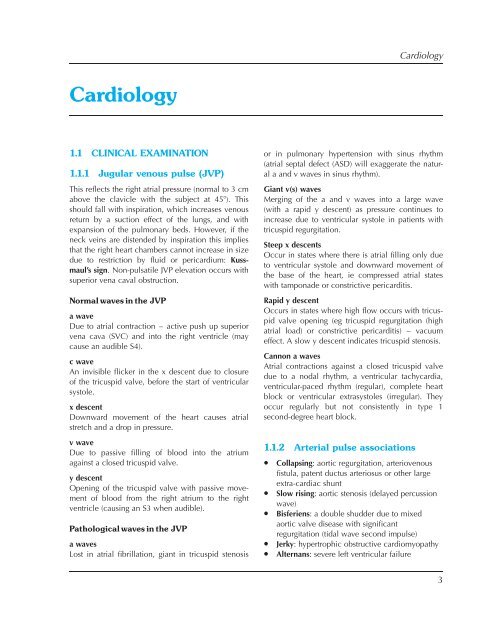Essential Revision Notes for MRCP Third Edition - PasTest
Essential Revision Notes for MRCP Third Edition - PasTest
Essential Revision Notes for MRCP Third Edition - PasTest
- No tags were found...
Create successful ePaper yourself
Turn your PDF publications into a flip-book with our unique Google optimized e-Paper software.
CardiologyCardiology1.1 CLINICAL EXAMINATION1.1.1 Jugular venous pulse (JVP)This reflects the right atrial pressure (normal to 3 cmabove the clavicle with the subject at 458). Thisshould fall with inspiration, which increases venousreturn by a suction effect of the lungs, and withexpansion of the pulmonary beds. However, if theneck veins are distended by inspiration this impliesthat the right heart chambers cannot increase in sizedue to restriction by fluid or pericardium: Kussmaul’ssign. Non-pulsatile JVP elevation occurs withsuperior vena caval obstruction.Normal waves in the JVPa waveDue to atrial contraction – active push up superiorvena cava (SVC) and into the right ventricle (maycause an audible S4).c waveAn invisible flicker in the x descent due to closureof the tricuspid valve, be<strong>for</strong>e the start of ventricularsystole.x descentDownward movement of the heart causes atrialstretch and a drop in pressure.v waveDue to passive filling of blood into the atriumagainst a closed tricuspid valve.y descentOpening of the tricuspid valve with passive movementof blood from the right atrium to the rightventricle (causing an S3 when audible).Pathological waves in the JVPa wavesLost in atrial fibrillation, giant in tricuspid stenosisor in pulmonary hypertension with sinus rhythm(atrial septal defect (ASD) will exaggerate the naturala and v waves in sinus rhythm).Giant v(s) wavesMerging of the a and v waves into a large wave(with a rapid y descent) as pressure continues toincrease due to ventricular systole in patients withtricuspid regurgitation.Steep x descentsOccur in states where there is atrial filling only dueto ventricular systole and downward movement ofthe base of the heart, ie compressed atrial stateswith tamponade or constrictive pericarditis.Rapid y descentOccurs in states where high flow occurs with tricuspidvalve opening (eg tricuspid regurgitation (highatrial load) or constrictive pericarditis) – vacuumeffect. A slow y descent indicates tricuspid stenosis.Cannon a wavesAtrial contractions against a closed tricuspid valvedue to a nodal rhythm, a ventricular tachycardia,ventricular-paced rhythm (regular), complete heartblock or ventricular extrasystoles (irregular). Theyoccur regularly but not consistently in type 1second-degree heart block.1.1.2 Arterial pulse associations• Collapsing: aortic regurgitation, arteriovenousfistula, patent ductus arteriosus or other largeextra-cardiac shunt• Slow rising: aortic stenosis (delayed percussionwave)• Bisferiens: a double shudder due to mixedaortic valve disease with significantregurgitation (tidal wave second impulse)• Jerky: hypertrophic obstructive cardiomyopathy• Alternans: severe left ventricular failure3
















